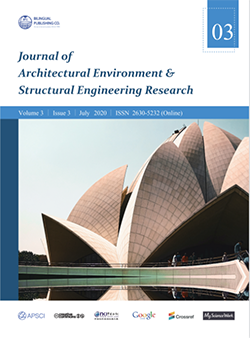-
363
-
201
-
200
-
187
-
182
Valuation of laterite in low-cost building in West Africa
DOI:
https://doi.org/10.30564/jaeser.v3i3.2059Abstract
The study of the performance of raw clay bricks has made it possible to develop laterite in Eco village construction projects. Identification tests (particle size analysis, Atterberg limits, Proctor, shrinkage limit, and sand equivalent) made it possible to characterize the laterite, the sand, and the E1 mixture (70% laterite and 30% sand). By adding binders to E1, three other types of mixtures E2, E3, and E4 have been proposed. The improved E1 sample:(1) At 2.5% of cement gives E2; (2) At 10% of lime gives E3; (3) with 0.8% lignosulfonates. After making the bricks using the samples E1, E2, E3, and E4, we perform uniform compression test at 3, 7, and 21 days. All samples have simple compressive strengths greater than 0.5 MPa (in accordance with standard NF EN 771-1) after 3 days. Their evolution from 0.5 to 2.5 MPa, between 3 and 7 days, shows a jump of 1.5. From 7 to 21 days the evolution curve of the Rc shows a slight ascension then a plateau pace (2.5, 2.51, 2.56 MPa). From these results, we concluded that they were used according to the area and the type of climate. The use of the sample E1 is proposed in arid zones or with low rainfall, the sample E2, and E3 in the rainy zones without risk of capillary rise and the sample E4 in the rainy zones with the risk of capillary rise
Keywords:
Brick; Cement; Lime; Lignosulfonates; Simple compression; Eco villageReferences
[1] Anger, R., Fontaine, L. Building on land, from a grain of sand to architecture, Belin editions, Paris,2009.
[2] Baudreu D. Habitats and fortifications in raw earth from medieval times in the south of France. 2003.
[3] Cammas C. Château de Vincennes, geo-archaeological report. Fouilles du manoir de Vincennes, 1991-1996, DFS, scientific report, 1996a, 16(1): 197-219.
[4] Cammas C. geo-archaeological study of the site of Saint-Denis (Grand-Stade). in Meyer O. (dir.), Dufour J.-Y., Marti F., Cammas C. , with the contribution of Péru J.-J., Gaborieau C., Madouri I., archaeological elements for an agrarian history of La Plaine Saint-Denis, Saint-Denis, 1996b(93).
[5] Fathy, H. Building with the people, Actes Sud editions, Arles, 1999.
[6] Gendreau D., Delboy L. Under the supervision of Joffroy T., CRAterre-ENSAG, 2010. World heritage,Inventory and situation of earthly goods, UNESCO /CH / CPM, Paris, 1999
[7] UN News Center. Habitat Day: By 2050, 3 billion people could live in slums, press release, 2005.
[8] Guillaud, H., Houben, H. Earth construction treaty,editions, 2006.
Downloads
How to Cite
Issue
Article Type
License
Copyright © 2020 Ibrahima SOW

This is an open access article under the Creative Commons Attribution-NonCommercial 4.0 International (CC BY-NC 4.0) License.




 Ibrahima Sow
Ibrahima Sow






